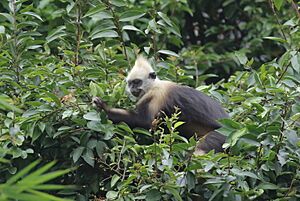White-headed langur facts for kids
Quick facts for kids White-headed langur |
|
|---|---|
 |
|
| Conservation status | |
| Scientific classification | |
| Synonyms | |
|
T. poliocephalus leucocephalus |
The white-headed langur (Trachypithecus leucocephalus) is a special type of monkey. It is a Critically Endangered species, meaning it is in great danger of disappearing forever. This langur lives only in Guangxi, China.
Contents
What is a White-Headed Langur?
The white-headed langur is a type of monkey known for its unique look. It has a mostly black body. But its head, cheeks, and neck are bright white! This makes it easy to tell apart from other monkeys.
Where Do White-Headed Langurs Live?
These langurs live in a very small area in southern China. They are found only in the Guangxi province. They prefer to live in rocky hills called karst hills. These hills have lots of caves and cliffs. The Zuo River acts like a natural border. It separates their home from where other similar monkeys live.
Why Are White-Headed Langurs Endangered?
The white-headed langur is listed as Critically Endangered. This means it faces a very high risk of becoming extinct. Scientists believe there are fewer than 600 of these langurs left. Only about 250 of them are old enough to have babies. Most groups have fewer than 25 langurs.
Main Threats to Langurs
There are a few big reasons why these langurs are in trouble:
- Hunting: People sometimes hunt these langurs illegally. This is called poaching.
- Losing Homes: Their natural homes are being destroyed. This is called habitat destruction. Forests are cut down, and land is changed for human use.
- Mixing Species: Another type of monkey, the François' langur, has been released into their area. These two types of langurs can have babies together. This mixing can weaken the white-headed langur's unique genes.
- Low Genetic Diversity: The langurs have very little variety in their genes. This makes them less able to fight diseases or adapt to changes in their environment.
All these problems make it very hard for the white-headed langur to survive and grow its population.
Images for kids



